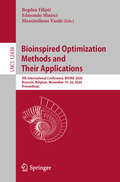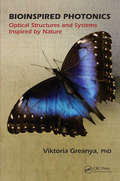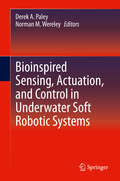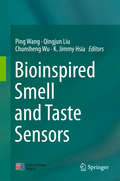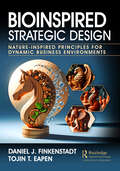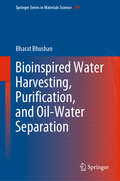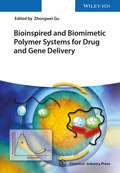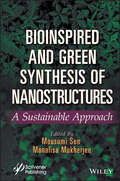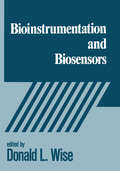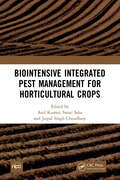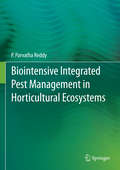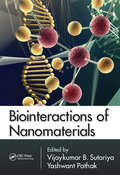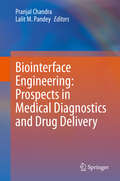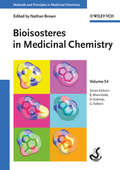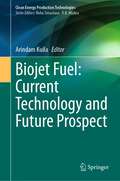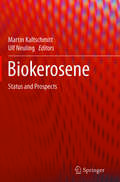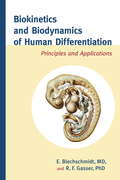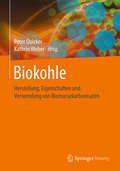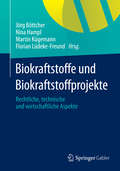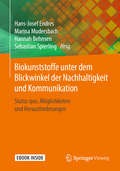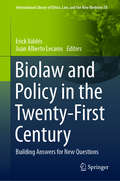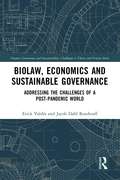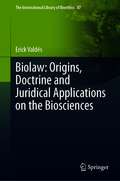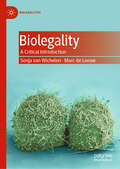- Table View
- List View
Bioinspired Optimization Methods and Their Applications: 9th International Conference, BIOMA 2020, Brussels, Belgium, November 19–20, 2020, Proceedings (Lecture Notes in Computer Science #12438)
by Massimiliano Vasile Edmondo Minisci Bogdan FilipičThis book constitutes the refereed proceedings of the 9th International Conference on Bioinspired Optimization Methods and Their Applications, BIOMA 2020, held in Brussels, Belgium, in November 2020. The 24 full papers presented in this book were carefully reviewed and selected from 68 submissions. The papers in this BIOMA proceedings specialized in bioinspired algorithms as a means for solving the optimization problems and came in two categories: theoretical studies and methodology advancements on the one hand, and algorithm adjustments and their applications on the other. Due to the Corona pandemic BIOMA 2020 was held as a virtual event.
Bioinspired Photonics: Optical Structures and Systems Inspired by Nature
by Viktoria GreanyaHarness the Wonders of the Natural World As our in-depth knowledge of biological systems increases, the number of devices and applications built from these principles is rapidly growing. Bioinspired Photonics: Optical Structures and Systems Inspired by Nature provides an interdisciplinary introduction to the captivating and diverse photonic systems
Bioinspired Sensing, Actuation, and Control in Underwater Soft Robotic Systems
by Derek A. Paley Norman M. WereleyThis book includes representative research from the state‑of‑the‑art in the emerging field of soft robotics, with a special focus on bioinspired soft robotics for underwater applications. Topics include novel materials, sensors, actuators, and system design for distributed estimation and control of soft robotic appendages inspired by the octopus and seastar. It summarizes the latest findings in an emerging field of bioinspired soft robotics for the underwater domain, primarily drawing from (but not limited to) an ongoing research program in bioinspired autonomous systems sponsored by the Office of Naval Research. The program has stimulated cross‑disciplinary research in biology, material science, computational mechanics, and systems and control for the purpose of creating novel robotic appendages for maritime applications. The book collects recent results in this area.
Bioinspired Smell and Taste Sensors
by Ping Wang Qingjun Liu Chunsheng Wu K. Jimmy HsiaThis book discusses the field of bioinspired smell and taste sensors which includes many new areas: sensitive materials, physiological modelling and simulation, and more. Similar to biological chemical sensing systems, bioinspired smell and taste sensors are characterized with fast responsive, high specificity and sensitivity. One of the most important parts of the field is that of sensitive elements originated from biological components, which enable the detection of chemical signals by mimicking the biological mechanisms. This book detailed describes processing, devices, recognition principles of sensitive materials, and concrete realizations. It is written for researchers, engineers and biologists who engages in interdisciplinary research and applications. Dr. Ping Wang is a professor at Zhejiang University, Hangzhou, China. Dr. Qingjun Liu is a professor at Zhejiang University, Hangzhou, China. Dr. Chunsheng Wu is an associated professor at Zhejiang University, Hangzhou, China. Dr. K. Jimmy Hsia is a professor at University of Illinois at Urbana-Champaign, Urbana, USA.
Bioinspired Strategic Design: Nature-Inspired Principles for Dynamic Business Environments
by Daniel J. Finkenstadt Tojin T. EapenOrganizations are commonly thrust into hostile operating environments where they are required to make strategic decisions that involve significant and costly tradeoffs. Such hostile environments may be endemic such as an economic recession or idiosyncratic such as a predatory action by an adversary. Many features of such hostile environments parallel those of living organisms that also demonstrate fine-tuned strategies to improve their survivability under adverse conditions. How can organizations use these “bioinspired strategies” to survive, and even potentially innovate? This book shows that the same three capabilities essential for the survival of living organisms in harsh environments – efficiency, resilience, and prominence – are also critical for organizations in their process of navigating through their own hostile environments. Throughout the book, the authors provide organizational executives with a systematic framework for thinking about strategic decision-making in a hostile environment leaning on analysis of real-world cases to draw out ontologies and methods for guiding their teams through disruptions, change management, innovation, and process improvements. In the first part, organizations are provided with a systematic approach to analyzing three survivability influences – forces, resources, and observers and their interrelationships. While all three influences are active across all organisms (and organizations), the exact nature of their interrelationship and the significance of each influence are unique to every organism (or organization). The framework helps organizations nail down the specific features of their operating environment that can help or hinder survivability by analyzing the three influences. Organizations can respond to external influences by developing three-pronged capabilities – efficiency, resilience, and prominence (ERP) – that respond to the three survivability influences. Organizations often struggle with identifying the appropriate strategies to apply under different conditions. Fortunately, nature provides several mechanisms that can be analogically applied to guide business strategies. The book contains many illustrations and examples of strategic principles observed among living organisms that can help an organization develop ERP capability. Finally, the book introduces seven strategic design heuristics – Combination, Elimination, Separation, Segmentation, Replication, Dynamics, and Maximization – observed in a living system that can be flexibly utilized to generate ideas to achieve strategic ends.
Bioinspired Systems for Translational Applications: 10th International Work-Conference on the Interplay Between Natural and Artificial Computation, IWINAC 2024, Olhâo, Portugal, June 4–7, 2024, Proceedings, Part II (Lecture Notes in Computer Science #14675)
by Hojjat Adeli José Manuel Ferrández Vicente Mikel Val CalvoThe two volume set LNCS 14674 and 14675 constitutes the proceedings of the 10th International Work-Conference on the Interplay Between Natural and Artificial Computation, IWINAC 2024, which took place in Olhâo, Portugal, during June 4–7, 2024. The 99 full papers presented in these proceedings were carefully reviewed and selected from 193 submissions. They were organized in topical sections as follows: Part I: Machine learning in neuroscience; artificial intelligence in neurophysiology; neuromotor and cognitive disorders; intelligent systems for assessment, treatment, and assistance in early stages of Alzheimer's disease and other dementias; socio-cognitive, affective and physiological computing; affective computing and context awareness in ambientintelliigence; learning tools to lecture; Part II: Machine learning in computer vision and robotics; bio-inspired computing approaches; social and civil engineering through human AI translations; smart renewable energies: advancing AI algorithms in the renewable energy industry; bioinspired applications.
Bioinspired Water Harvesting, Purification, and Oil-Water Separation (Springer Series in Materials Science #299)
by Bharat BhushanThis book presents an overview of arid desert conditions and natural mechanisms for water harvesting from fog and condensation, providing data on various bioinspired surfaces for water collection. It discusses consumer to military and emergency applications. It presents various designs for water harvesting towers and projections for water collection, and describes innovative approaches to bioinspired water desalination, water purification and oil-water separation.Fresh water sustains human life and is vital for health. However, water scarcity affects more than 40% of the global population and is projected to rise, especially in some of the world’s most impoverished countries. Additionally, water contamination is one of the most critical environmental and natural resource concerns of the 21st century. This book addresses these topics with a presentation of the development of sustainable and environmentally friendly bioinspired surfaces for water harvesting from fog and condensation, as well as bioinspired oil-water separation techniques for removing oil contaminants from oil-water mixtures and oil-water emulsions.Intended for novices as well as experts in the field, the book offers actionable insight for practitioners, solution seekers, and the generally curious alike. It serves as an excellent accompanying text for one-semester courses in biomimetics, water supply and management, or environmental engineering.
Bioinspired and Biomimetic Polymer Systems for Drug and Gene Delivery
by Zhongwei GuHere, front-line researchers in the booming field of nanobiotechnology describe the most promising approaches for bioinspired drug delivery, encompassing small molecule delivery, delivery of therapeutic proteins and gene delivery. The carriers surveyed include polymeric, proteinaceous and lipid systems on the nanoscale, with a focus on their adaptability for different cargoes and target tissues.Thanks to the broad coverage of carriers as well as cargoes discussed, every researcher in the field will find valuable information here.
Bioinspired and Green Synthesis of Nanostructures: A Sustainable Approach
by Mousumi Sen Monalisa MukherjeeBIOINSPIRED AND GREEN SYNTHESIS OF NANOSTRUCTURES This unique book details various ways to synthesize advanced nanostructures using green methods, explores the design and development of sustainable advanced nanostructures, and discusses the antimicrobial and antiviral applications. The future of the world depends on immediately investing our time and effort in advancing ideas on ways to restrict the use of hazardous chemicals, thereby arresting further environmental degradation. To achieve this goal, nanotechnology has been an indispensable arena that has extended its wings into every aspect of modernization. For example, green synthetic protocols are being extensively researched to inhibit the harmful effects of chemical residues and reduce chemical wastes. This involves the study of nanotechnology for artful engineering at the molecular level across multiple disciplines. In recent years, nanotechnology has ventured away from the confines of the laboratory and has been able to conquer new domains to help us live better lives. Bioinspired and Green Synthesis of Nanostructures focuses on the recent developments and novel applications of bioinspired and biomimetic nanostructures as functionally advanced biomolecules with huge prospects for research, development, and engineering industries. It provides detailed coverage of the chemistry of each major class of synthesis of bioinspired nanostructures and their multiple functionalities. In addition, it reviews the new research results currently being introduced and analyzes the various green synthetic approaches for developing nanostructures, their distinctive characteristics, and their applications. The book provides readers with an understanding of the recent data, as well as various strategies for designing and developing advanced nanostructures using a greener approach. Audience The core audience of this book include materials scientists, nanoscientists, nanotechnologists, chemical and biological engineers, biochemists and biotechnologists. Industry process engineers and scientists working in nanomaterial synthesis will find this book extremely valuable.
Bioinstrumentation and Biosensors
by Donald L. WiseThis reference text consists of contributed chapters by specialists directly carrying out research and development in this emerging field which joins advanced microelectronics with modern biotechnology. Chapters present novel biotechnology-based microelectronic instruments, such as those used for de
Biointensive Integrated Pest Management for Horticultural Crops
by Anil KumarThe book has covered recent techniques on bio-intensive integrated approaches of horticultural pest’s management. An attempt to compile information on non-chemical ways of pest management strategies including agronomic approaches to physical, mechanical, biopesticides, biocontrol agents, biorational pesticides etc. which are non harmful to environment and economically viable has been made. This book is a useful reference material for organic product producing farmers, researchers and students who are involved in bio-intensive pest management strategies.Note: T& F does not sell or distribute the hardback in India, Pakistan, Nepal, Bhutan, Bangladesh and Sri Lanka. This title is co-published with NIPA.
Biointensive Integrated Pest Management in Horticultural Ecosystems
by P. Parvatha ReddyThrough 'Green Revolution' in late 1960s, India achieved self-sufficiency in food production, but still the country has not achieved self-sufficiency in production of horticultural crops. Most of the growth in food production during the green revolution period is attributed to the use of higher levels of fertilizers and pesticides which are continuing to destroy stable traditional ecosystems. The challenge before the crop protection scientist is to increase yields from the existing land without harming the environment and resource base. This can be achieved by adopting eco-friendly Biointensive Integrated Pest Management (BIPM) strategy. BIPM incorporates ecological and economic factors into agricultural system design and decision making, and addresses public concerns about environmental quality and food safety. The benefits of implementing BIPM can include reduced chemical input costs, reduced on-farm and off-farm environmental impacts, and more effective and sustainable pest management. An ecology-based IPM has the potential of decreasing inputs of fuel, machinery, and synthetic chemicals-all of which are energy intensive and increasingly costly in terms of financial and environmental impact. Such reductions will benefit the grower and society. The present book deals with the most recent biointensive integrated approaches for pest management utilizing components such as bioagents [predators, parasitoids and pathogens (bacteria, fungi, viruses)], botanicals (biofumigation, oil cakes, FYM, compost, crop residues, green manuring and other organic amendments), arbuscular mycorrhizal fungi, physical methods (hot water treatment of planting material, soil solarization), cultural methods (crop rotation, summer ploughing, fallowing, intercropping, pruning, mulching, spacing, planting date, trap cropping, etc. ), biorational chemicals (pheromones) and resistant cultivars. This book can serve as a useful reference to policy makers, research and extension workers, practicing farmers and students. The material can also be used for teaching post-graduate courses.
Biointeractions of Nanomaterials
by Yashwant Pathak Vijaykumar B. SutariyaAn examination of the widespread application of nano materials in biology, medicine, and pharmaceuticals and the accompanying safety concerns, Bio-interactions of Nano Materials addresses the issues related to toxicity and safety of nano materials and nano systems. It covers the interactions in biological systems and presents various tools and meth
Biointerface Engineering: Prospects in Medical Diagnostics and Drug Delivery
by Pranjal Chandra Lalit M. PandeyThis book provides detailed information on the surface and surface chemistry of various biointerfaces for the understanding and development of biosensors, biocompatible devices, and drug delivery systems. It highlights the role of interfacial phenomena towards the behaviour of biomolecules on different surfaces and their significance in recent applications. The book also addresses various surface engineering techniques for the modification of biomaterials that are implemented for improving biocompatibility. It provides an updated scientific concept of various interactions of biological systems with surfaces/modified surfaces at the molecular and cellular level. The chapters include various in-vitro, in-vivo, ex-vivo models to illustrate various aspects of Biointerface Engineering. Finally, the book elucidates troubleshooting strategies and future prospects of Biointerface Engineering in Medical Diagnostics and Drug Delivery.
Bioisosteres in Medicinal Chemistry
by Nathan Brown Raimund Mannhold Gerd Folkers Hugo KubinyiWritten with the practicing medicinal chemist in mind, this is the first modern handbook to systematically address the topic of bioisosterism.As such, it provides a ready reference on the principles and methods of bioisosteric replacement as a key tool in preclinical drug development.The first part provides an overview of bioisosterism, classical bioisosteres and typical molecular interactions that need to be considered,while the second part describes a number of molecular databases as sources of bioisosteric identification and rationalization. The third partcovers the four key methodologies for bioisostere identification and replacement: physicochemical properties, topology, shape, and overlays ofprotein-ligand crystal structures. In the final part, several real-world examples of bioisosterism in drug discovery projects are discussed.With its detailed descriptions of databases, methods and real-life case studies, this is tailor-made for busy industrial researchers with little time for reading, while remaining easily accessible to novice drug developers due to its systematic structure and introductory section.
Biojet Fuel: Current Technology and Future Prospect (Clean Energy Production Technologies)
by Arindam KuilaThis book covers the basic knowledge of biojet fuel, explores the current technological status, and presents future prospects for commercial biojet fuel production. The focus of this book is on biojet fuel production from different types of potential substrates. It also includes technoeconomic analysis and life cycle assessment of biojet fuel. Biojet fuel is currently recognized as the best alternative to petroleum-based jet fuel due to its renewability and sustainable features. However, there is a scarcity of reports on biojet fuel production from various types of substrates.The aviation industry globally consumes approximately 200 million tonnes of jet fuels each year, with a projected continuous growth rate of 5% per year until 2050 (Seymour et al., 2020). Currently, the global demand for jet fuel is predominantly met by petroleum-based fuels. However, the limited availability of fossil fuels and increasing concerns about climate change have placed significant pressure on commercial airlines to reduce greenhouse gas emissions and embrace cleaner and more sustainable practices.Biojet fuel has emerged as the most favorable alternative to petroleum-based jet fuel due to its renewable nature and sustainable characteristics. Despite its potential, there is a limited number of reports available on the production of biojet fuel from different types of substrates. The present scenario of biojet fuel necessitates the development of improved and cost-effective technologies that can yield long-term benefits.The book is useful for students and researchers in various branches of life sciences, including environmental biotechnology, bioprocess engineering, renewable energy, chemical engineering, nanotechnology, biotechnology, microbiology, and more.
Biokerosene: Status and Prospects
by Martin Kaltschmitt Ulf NeulingThe book provides a detailed overview of the biokerosene supply chain. It describes the current market situation for aviation fuels and their demands, which will continue to increase during the coming years. On the other hand, the available resources of fossil fuel energy are limited. In order to solve these problems new ways to produce biokerosene have been discussed. So the authors give an in-depth description of classical and new non-edible biomass feedstock. For a broad variety of possible feedstock materials, the state of the art of biokerosene production is discussed taking into account the fuel standards which have to be fulfilled. Experiences from different long-term test flights are presented, and an overall assessment of the currently available conversion pathways from biomass to biokerosene are given.
Biokinetics and Biodynamics of Human Differentiation
by R. F. Gasser E. BlechschmidtFifty years ago the field of human embryology was incomplete; prior to that time the anatomy of early human embryos was still unknown, and there was much to be learned about the older stages of human embryonic development. It is now understood that human organs result from step-by-step differentiations of the growing human embryo. Research by renowned embryologist Erich Blechschmidt, MD, showed that differentiations are not only the result of a gene effect, but are also brought about through growth initiated by extragenetic (occurring outside the gene) information. Without this extragenetic information the differentiation would not begin. Dr. Blechschmidt and coauthor Raymond Gasser, PhD, maintain that Haeckel's biogenetic law (ontogeny recapitulates phylogeny) was an erroneous attempt to explain developmental processes. Blechschmidt's human embryological investigations showed that Darwin's principles (mutation and selection) are likely valid for the origin of the species, but that they cannot explain the ontogenesis of the organs. The ontogenesis of each individual cannot be derived from phylogenetic facts. The authors stress that a clear distinction must be made between the vast field of phylogenetics and the much more exact and understandable field of ontogenetics--particularly the process of differentiation--and their goal is to present not only the abstract biokinetic principles of differentiation, but the originality of embryonic human beings as well. Their knowledge of developmental movements leads to their conclusion that differentiation is an undivided biodynamic process that occurs during development and includes the chemical processes as well. Logically organized into two sections (the first covers early metabolic fields and includes chapters on the one-cell human ovum, the early embryo, blood vessels, the nervous system, head region, trunk, and limbs; the second describes metabolic fields in later developmental stages, distinguishing fields of corrosion, densation, contusion, distusion, retention, dilation, liquation, and detraction), Biokinetics and Biodynamics of Human Differentiation warrants reading by thoughtful professionals in a number of fields concerned with embryonic differentiation. A new preface by Dr. Gasser addresses how the book's principles and findings were and are understood in the field of human embryology.
Biokohle: Herstellung, Eigenschaften und Verwendung von Biomassekarbonisaten
by Andrea Kruse Peter Quicker Kathrin Weber Dennis Blöhse Thomas Echterhof Sabrina Eichenauer Simone Heger Claudia Kammann Marc-André Schulten Christoph Sager Saulo Seabra Klaus Serfass Ernst StadlbauerBiomassekarbonisate (Biokohlen) besitzen signifikant unterschiedliche Eigenschaften, die von den Herstellungsverfahren, Prozessbedingungen und Ausgangssubstraten abhängen. Im Buch sind die technisch verfügbaren Verfahren zur Erzeugung von Biokohle beschrieben und die thermochemischen Prozesse erörtert. Anhand von zahlreichen farbigen Abbildungen sind die Prozesse, Eigenschaften und Einsatzmöglichkeiten veranschaulicht. Der Fokus des Buches liegt auf den großtechnischen Anwendungen als Energieträger, als Reduktions- oder Aufkohlungsmittel in metallurgischen Verfahren, in Recyclingprozessen oder in Kraft- und Zementwerken. Aber auch die Anwendung von Biomassekarbonisaten in der Landwirtschaft als Bodenhilfsstoff oder in der Tierhaltung ist aufgezeigt.
Biokraftstoffe und Biokraftstoffprojekte: Rechtliche, technische und wirtschaftliche Aspekte
by Jörg Böttcher Nina Hampl Martin Kügemann Florian Lüdeke-FreundDieses Buch beschäftigt sich mit Biokraftstoffen und Biokraftstoffprojekten. Die Autoren zeigen auf, welche rechtlichen, agrarischen, ökologischen und ökonomischen Rahmenbedingungen von Biokraftstoffen beachtet werden müssen. Die Betrachtung dieser Rahmenbedingungen und weiterer - eher anlagenbezogener - Faktoren ermöglicht es dann, Rückschlüsse auf die Realisierung von Biokraftstoffvorhaben zu ziehen. Besonderes Augenmerk wird dabei auf den sensiblen Themenkomplex der Nachhaltigkeit von Biokraftstoffen gerichtet. Die anhaltende Diskussion unerwünschter sozialer, ökologischer und ökonomischer Effekte hat zu neuen und bislang nicht abschließend definierten gesellschaftlichen und politischen Ansprüchen an die Biokraftstoffindustrie geführt.
Biokunststoffe unter dem Blickwinkel der Nachhaltigkeit und Kommunikation: Status quo, Möglichkeiten und Herausforderungen
by Hans-Josef Endres Marina Mudersbach Hannah Behnsen Sebastian SpierlingDas Buch zeigt, wie eine Nachhaltigkeitsbewertung von Biokunststoffen gelingen kann und wie die Ergebnisse einer solchen Bewertung ausfallen. Es analysiert die öffentliche Wahrnehmung beim Verbraucher sowie die politischen Rahmenbedingungen von Biokunststoffen.
Biolaw and Policy in the Twenty-First Century
by Erick Valdés Juan Alberto LecarosThis book offers an impressive collection of contributions on the epistemology of international biolaw and its applications, both in the legal and ethical fields. Bringing together works by some of the world’s most prominent experts on biolaw and bioethics, it constitutes a paradigmatic text in its field. In addition to exploring various ideologies and philosophies, including European, American and Mediterranean biolaw traditions, it addresses controversial topics straight from today’s headlines, such as genetic editing, the dual-use dilemma, and neurocognitive enhancement. The book encourages readers to think objectively and impartially in order to resolve the ethical and juridical dilemmas that stem from biotechnological empowerment and biomedical techniques. Accordingly, it offers a valuable resource for courses on biolaw, law, bioethics, and biomedical research, as well as courses that discuss law and the biosciences at different professional levels, e.g. in the courts, biomedical industry, pharmacological companies and the public space in general.
Biolaw, Economics and Sustainable Governance: Addressing the Challenges of a Post-Pandemic World (Finance, Governance and Sustainability)
by Erick Valdés Jacob Dahl RendtorffThis book offers an accurate and updated approach to the main contributions of cosmopolitan biolaw in relation to sustainability, global governance, organizational health care economics and COVID-19. Bringing together different robust and dense biojuridical epistemologies to analyze key bioethical problems as well as the health care, management, economics and sustainability issues of our time, it constitutes a paradigmatic text in its field. In addition to exploring different epistemologies and jurisdictional scopes of biolaw, including the relationships between this new field and the challenges which have arisen in the current globalized and technologized world, the book addresses controversial issues straight from today’s headlines: for example, the basics for health care, finance and organizational economics, global biojuridical principles for governance, globalization, bioscientific empowerment, global and existential risk and sustainability challenges for a post-pandemic world. The book encourages readers to think impartially in order to know and understand the bioethical and biojuridical dilemmas that stem from current economics and sustainability issues. Accordingly, it will be a valuable resource for courses in the fields of biolaw, law, bioethics, global sustainability, organizational health care economics, and global governance at different professional levels.
Biolaw: Origins, Doctrine and Juridical Applications on the Biosciences (The International Library of Bioethics #87)
by Erick ValdésThis book configures a consistent epistemology of biolaw that distinguishes itself from bioethics and from a mere set of international instruments on the regulation of biomedical practices. Such orthodox intellection has prevented biolaw from being understood as a new branch of law with legally binding force, which has certainly dwindled its epistemological density. Hence, this is a revolutionary book as it seeks to deconstruct the history of biolaw and its oblique epistemologies, which means not accepting perennial axioms, and not seeing paradigms where only anachronism and anomaly still exist. It is a book aimed at validity, but also at solidity because the truth of biolaw has never been told before. In that sense, it is also a revealing text. The book shapes biolaw as an independent and compelling branch of law, with a legally binding scope, which boosts the effectiveness of new deliberative models for legal sciences, as well as it utterly reinforces hermeneutical and epistemological approaches, in tune with the complexity of disturbing legal scenarios created by biomedical sciences’ latest applications. This work adeptly addresses the origins of the European biolaw and its connections with American bioethics. It also analyses different biolaw’s epistemologies historically developed both in Europe and in the United States, to finally offer a new conception of biolaw as a new branch of law, by exploring its theoretical and practical atmospheres to avoid muddle and uncertainty when applied in biomedical settings. This book is suitable for academics and students of biolaw, law, bioethics, and biomedical research, as well as for professionals in higher education institutions, courts, the biomedical industry, and pharmacological companies.
Biolegality: A Critical Introduction (Biolegalities)
by Marc de Leeuw Sonja van WichelenThis book provides a comprehensive analysis of the empirical and theoretical problems posed by the encounter between law and biology in the twenty-first century. How does biotechnology and new bioscientific knowledge affect our legal institutions, our sense of justice, and our ways of relating to one another? To answer these questions, authors Marc de Leeuw and Sonja van Wichelen examine the complex and often contested ways in which biotechnology and biological knowledge are reworked by, with, and against legal knowledge. As this book shows, recent developments in the life sciences—including molecular biology, immunology, and the neurosciences—and their applications in forensics, medicine, and agriculture test longstanding legal forms, such as property, personhood, parenthood, and (collective) identity, ultimately constituting the current field of “biolegality.” The authors argue that these biolegal contestations represent philosophical and anthropological challenges to existing understandings of exchange, self, kinship, and community. By addressing how biology and law inform new ways of relating and knowing, the book proposes a programmatic intervention, asserting the pivotal role the study of biolegality plays in advancing social and political theory.
